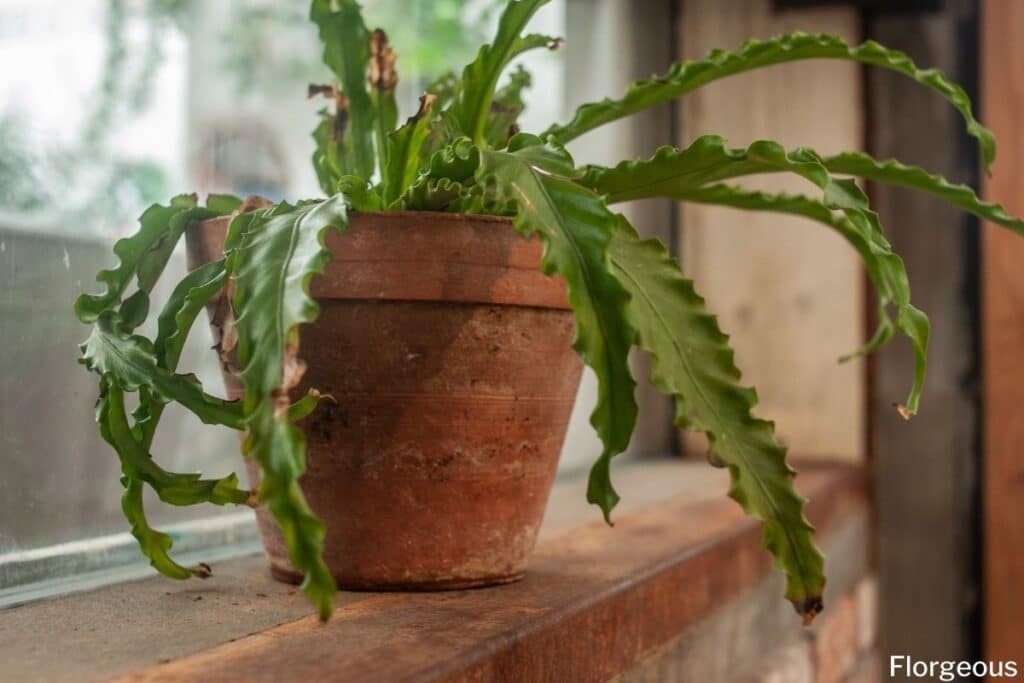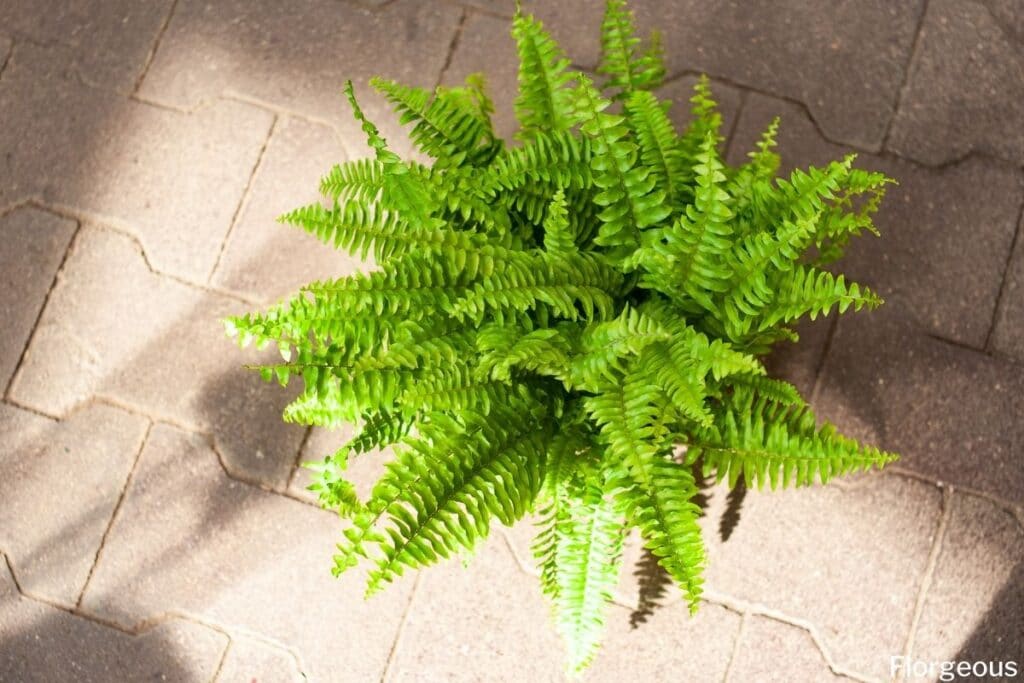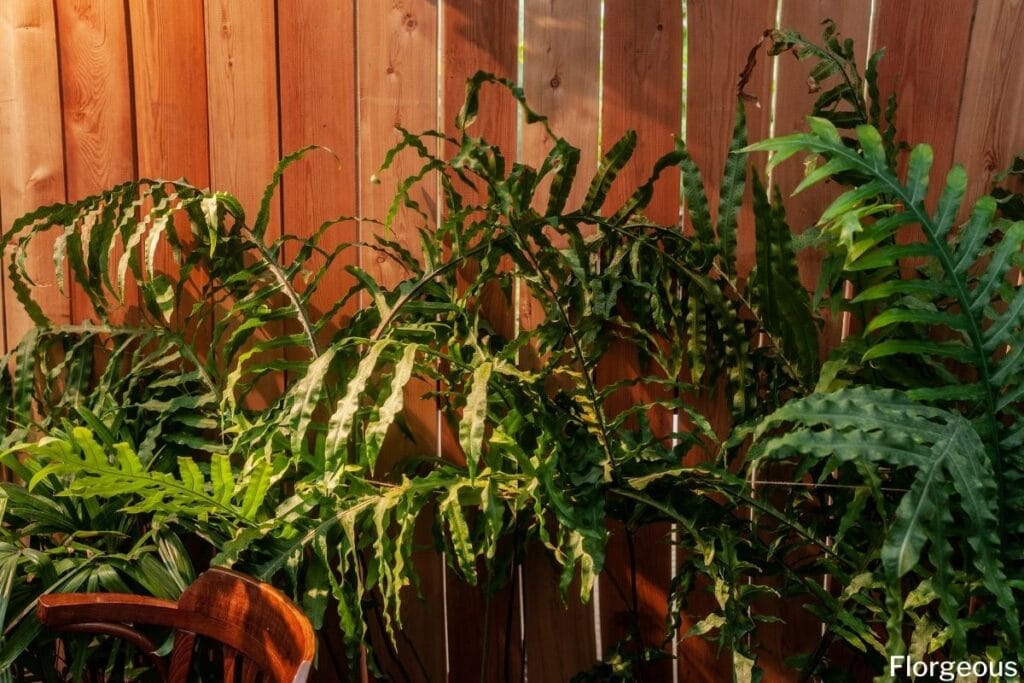Ferns make fantastic houseplants. There are thousands of species that have learned to adapt and grow for millions of years.
Ferns are quite literally one of the oldest plants on planet earth. Over time, they have learned to grow in a variety of conditions, which makes them perfect candidates as houseplants.
There is a fern plant that will work for you, no matter your local climate, budget, or gardening experience as long as you know the basics when it comes to fern care.
Keep on reading to learn about some of the most popular and reliable houseplants money can buy. We are certain you will find a species you grow and that will bring a much-needed pop of character to your home or garden.
1. Bird’s Nest Fern (Asplenium nidus)

The Bird’s Nest Fern is an epiphytic species whose fronds roughly resemble the shape of a bird’s nest. In the wild, this plant typically grows on the surface of tree branches and trunks.
Because this plant is epiphytic, it receives its water nutrients from the humidity and soil debris in the air. As a houseplant, you can mount it onto a piece of wood, a mixture of wood chips, or sphagnum moss. Generally, you should not plant it directly into the soil.
The Bird’s Nest Fern is a low-maintenance indoor fern that likes average temperatures, moist growing substrate, and humidity. You can keep this plant happy by locating it somewhere it can get bright, indirect sunlight.
See more: Bird’s nest fern care
2. Boston Fern (Nephrolepis exaltata)

The Boston Fern is one of the most common varieties you will see indoors. Its light green and delicate fronds are the classic shape and size for foliage. In addition, these plants are popular as houseplants because they are one of the easiest species to take care of. We especially enjoy Boston Ferns in hanging containers where their beautiful fronds can grow long and cascade downwards.
Like other species, the Nephrolepis exaltata does well with indirect, filtered, or dappled light. Because the foliage of this species is so delicate, exposure to direct sunlight can burn the leaves. These indoor fern plants prefer moist soil but can tolerate drying out in between waterings.
3. Cretan Brake Fern (Pteris cretica)
The Cretan Brake Fern, also known as the Ribbon Fern, is one of the more common houseplant varieties. It is originally from different regions scattered around Europe, Asia, and Africa. This plant is a hardy variety and can tolerate drying out between waterings in comparison to other varieties that will die.
A peat-based potting mix is ideal for the Cretan Brake fern. You can fertilize this plant with a diluted liquid fertilizer every month or so to encourage more vigorous growth. To keep up with the growth of this plant, it may be necessary to re-pot the plant once every couple of years. You can also divide the plant by its rhizomes to grow more ferns, or give a section of it as a gift.
4. Maidenhair Fern (Adiantum raddianum)

The Maidenhair species is a slow-growing species with wiry black stems and delicate, green, and fan-shaped leaf segments. They are non-flowering, prefer a neutral soil pH level, and are native to North America.
Maidenhair plants do well with a bit of shade and indirect sunlight. The foliage can be burned from too much exposure to direct sunlight. This species prefers consistently moist soil. We recommend weekly waterings, especially during hotter and drier months of the year.
5. Rabbit’s Foot Fern (Davallia fejeensis)
The Rabbit’s Foot Fern plant is not as temperamental as other ferns but is equally beautiful. It receives its name from the furry rhizomes that sprout from the base of the plant. The rhizomes of the plant are actually responsible for collecting moisture from the air. It likes bright, indirect sunlight. For that reason, we recommend placing a Rabbit’s Foot Fern in an east or west-facing window.
This plant enjoys weekly waterings. Just make sure the soil is draining well so that the plant does not sit in oversaturated soil. If you want to encourage growth, you can feed your plant with a diluted liquid fertilizer every couple of months during the growing season. Make sure to hold off on fertilizing during the winter months when the plant is not actively growing.
6. Asparagus Fern (Asparagus aethiopicus)
The Asparagus Fern is known for its fuzzy and fluffy-looking foliage. Ironically, however, this plant has tons of tiny thorns along with its frogs that can cause irritation to the skin if touched. This is not a reason to avoid this plant! We love how it looks and have no problem putting on gloves when working with the plant.
The Asparagus Fern is technically not a fern at all, despite its name. It’s actually part of the Liliaceae family. This plant looks awesome in hanging containers. It performs well as an outdoor houseplant in humid environments, decorating the patio for example. It can also be kept indoors but will require a little extra work to keep it happily humid.
7. Horsetail Fern (Equisetum)
The Horsetail Fern is one of the most unique-looking houseplants we have seen. It has thin stalks that grow vertically. The stalks slightly resemble bamboo or other types of tall grass. This is one of the oldest ferns, dating back to the Paleozoic era. It is the last surviving plant of the Equisetum family.
Interestingly, the Horsetail Fern, despite its name, can actually be poisonous to horses if they are ingested.
8. Holly Fern (Cyrtomium falcatum)
The Holly Fern, also known as the Japanese Holly Fern, is unlike other species because it prefers low light if not mostly shade. It is native to parts of East Asia but has risen in popularity among the ranks of houseplants.
This species has light to dark-green foliage. Its leaves taper off to form a point on one end and have ridges along the fringes. It likes rich, moist soil, but be careful with overwatering.
Because these holly ferns like the shade, they won’t dry out as quickly as other species and may not require super frequent watering.
9. Staghorn Fern (Platycerium)
The Staghorn Fern gets its name from its antler-like fronds. This species is epiphytic, meaning that it grows on the surface of other objects like trees and rocks. For that reason, these plants do well when mounted onto a piece of wood. You can water it by soaking the piece of wood for 10 or 15 minutes. Letting it dry out between waterings is perfectly okay.
The Staghorn ferns do well in an environment with high humidity. You can mist this species to help raise the local humidity. This plant is known for its long life span. Its longevity is one of our favorite characteristics.
10. Kangaroo Paw Fern (Microsorum diversifolium)
The Kangaroo Paw Fern is an exciting species because its foliage grows in a unique way. The arching fronds of this plant tend to grow in different shapes and sizes, which gives it a unique and wild appearance.
The Kangaroo Paw likes routine maintenance. Moist soil, high humidity, and indirect sunlight. This kangaroo fern does not disappoint as a decorative table plant or windowsill decoration.
11. Lemon Button Fern (Nephrolepis cordifolia “Duffii”)
We love this variety of fern for its delicate and precious round, button-like foliage. We also really enjoy the slight lemony scent that it can produce. Plus, it tends to be even more low maintenance than other species. It’s not too finicky about light and can tolerate some periods of drought. It’s the perfect species for beginners for those very reasons.
12. Crocodile Fern (Microsorum musifolium)
This species gets its name from its green leathery fronds that resemble the skin of crocodiles (or alligators for that matter). Because of its unique appearance, the Crocodile Fern is a popular choice for decorative houseplants. In the wild, they are typically found throughout Southeast Asia, and some parts of Australia.
Because their native habitats are so humid, it’s important to keep the plant in a humid environment at home.
One of the best places for a humidity-loving plant is in the bathroom because it can soak up all the moisture from steamy, hot showers. But if you decide to grow it in other parts of the home, just make sure to spritz your houseplant weekly, or to keep it in a humidity tray. If you are really struggling with humidity, you may even consider using a humidifying machine.
13. ‘Gray Ghost’ Lady Fern (Athyrium niponicum)
As you might assume, the Gray Ghost has silvery-white foliage. This is a shade-loving species. Make sure to position the plant somewhere where it will not be exposed to bright, direct or indirect sunlight. It prefers loamy, light soil, but has been known to tolerate sandy and clay-like soils as well.
In a container, it can grow to be about 2 or 3 feet tall which we think is the ideal size for indoors. If you do need to control the size, some pruning can be done. On the other hand, if the Gray Ghost begins to outgrow its current container, you may need to transplant it to a new pot in order to avoid root bounding.
14. Hart’s Tongue Fern (Asplenium scolipendrium)
The leaves of the Hart’s Tongue Fern are light-green glossy and exotic-looking. The leaves are not divided, serrated, or frilled like other species. Instead, they look like little tongues. They do great in containers, but also in garden beds. You can even use this species as ground cover outdoors.
This houseplant is very versatile. It can grow in any type of soil, whether it be clay-like, sandy, or loamy, so long as the pH level hovers around neutral. It is one of the smaller varieties, and normally only grows to be 1 or 2 feet tall. It prefers partially shady sunlight exposure and is the best with filtered light.
15. Hen and Chickens Fern (Asplenium bulbiferun)
With a name like that, how could you not want this species? Hen and Chickens is a unique species with light-green, tiny, and needle-like foliage. The plant fronds arch elegantly from the center of the plant and even slightly resemble pine branches. This variety is perfect as a decorative piece for patios, terraces, and even indoors in hanging pots or as table pieces.
If outdoors, this plant can grow to be between 3 and 4 feet tall. However, indoors, it tends to remain smaller, especially if you have it in a smaller container. It prefers filtered, indirect sunlight and partial shade.
16. ‘Painted’ Lady Fern (Athyrium niponicum)
The Painted Lady Fern is a close relative of the Gray Ghost Fern already mentioned above. The foliage has a similar shape and style, however, this variety boasts a very beautiful burgundy-purple shade.
As the plant matures, the older foliage slowly transitions to a unique silver-green color, which contrasts well with the younger, burgundy-colored shoots coming in at the bottom of the plant. Because of its beautiful colors, we love this variety as an attractive holiday decoration.
17. Eagle Fern (Pteridium aquilinum)
This is a classic looking plant, with dark-green, divided, and triangular-shaped fronds. It is slightly lesser-known compared to some other varieties but is very popular in East Asia where it is actually used in some food dishes.
This species is one of the larger varieties available, so make sure you have plenty of room. It routinely grows to be about 4 feet tall, but has been known to grow as tall as 6 feet! Its larger size makes it ideal for big containers in large rooms, or as a commanding presence in outdoor gardens.
Ferns Are The Houseplants You Have Been Searching For
Finding the right houseplant can be difficult. You have to consider your local climate, where you want its container to be located, and how you plan to take care of it. It can also be tricky to find a plant that matches your style and the aesthetic of your home.
The great part about ferns is that there are thousands to choose from. There is absolutely a fern out there that will suit your intended usage, gardening expertise, and personal style. You just have to remain patient, research lots and select the fern that matches all your criteria.
FAQs
Which ferns are best for indoors?
Some ferns that are well-suited for indoor growing include the Boston fern (Nephrolepis exaltata), Maidenhair fern (Adiantum spp.), Bird’s Nest fern (Asplenium nidus), and Kimberly Queen fern (Nephrolepis obliterata). These ferns tolerate indoor conditions well and can thrive with proper care.
How many types of indoor ferns are there?
There are numerous types of indoor ferns, with varieties suited to different light levels, humidity levels, and growing conditions. Some common types of indoor ferns include Boston fern, Maidenhair fern, Staghorn fern, Bird’s Nest fern, Kimberly Queen fern, and Rabbit’s Foot fern, among others.
What is the best fern for a dark room?
The Maidenhair fern (Adiantum spp.) is often considered one of the best ferns for a dark room. While it prefers bright, indirect light, Maidenhair ferns can tolerate lower light conditions better than many other fern species. However, it’s important to provide some natural or artificial light to ensure the fern’s health and growth, even in a dark room.







